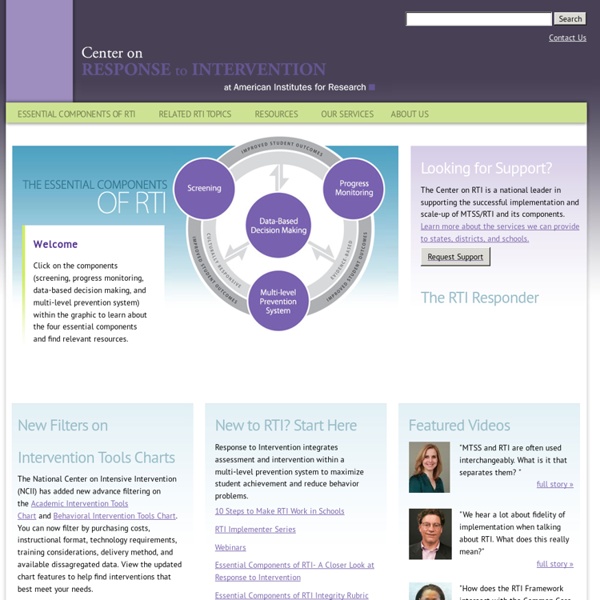



National Research Center on Learning Disabilities (NRCLD) Welcome to The IRIS Center TESOL International Association NECTAC: National Early Childhood Technical Assistance Center RTI in the Classroom – Virtual Visits | RTI Action Network The RTI Action Network travels to schools across the nation to find examples of real people doing real work with RTI. These Virtual Visits offer you frontline perspectives combined with informative stories of schools implementing RTI with success and dedication. Implementing Response to Intervention — Prairie Children Preschool A visit to Prairie Children Preschool in Aurora, Illinois, to discuss how they have been successfully implementing RTI in the early childhood setting for several years. Principal LuAnn Shields and her staff discuss their success and their challenges as well as critical RTI issues like delivering quality core instruction and tiered interventions to support children's development across domains. Let the Prairie Children Preschool team walk you and your staff through the RTI process from beginning to end. Russell Middle School, Colorado Springs, Colorado Let Russell Middle School walk you and your team through the RTI process from beginning to end.
Home School Violence and youth: Psychology’s response This summary report by the American Psychological Association's Commission on Violence and Youth examines individual and societal factors that contribute to youth violence in the United States and offers intervention strategies to reduce such violence. It examines biological, family, school, emotional, cognitive, social, and cultural factors which contribute to violent behavior. Applying Behavior Analysis to School Violence and Discipline Problems: School-Wide Positive Behavior Support School discipline is a growing concern in the United States. Best practices in school discipline A book chapter from the book 'Best Practices in School Psychology-II.' First Step to Success: An early intervention for elementary children at risk for antisocial behavior The increased prevalence and seriousness of antisocial behavior displayed by today's youths have become serious concerns for parents, educators, and community members. Positive behavior support.
Laureate Learning Systems: Special Needs Software for PC and Mac LD OnLine: The world's leading website on learning disabilities and ADHD Response to Intervention (RTI) Response to Intervention Task Force The charge of IRA's RTI Task Force is to link the talents of IRA members with opportunities for involvement in implementation and professional development. Interested in participating in RTI-related activities? Contact IRA at irawash@reading.org or call 202-624-8800 for the name of your RTI Task Force state IRA council representative. Read the draft version of their paper IRA Commission on RTI: Meeting the Needs of Culturally and Linguistically Diverse Students. Response to Intervention: Guiding Principles for Educators To further clarify issues related to RTI with respect to language and literacy, the RTI Task Force offers the following set of principles as a guide to IRA members and others concerned with developing and implementing an RTI approach to improving the language and literacy learning of all students. Response to Intervention in the Individual with Disabilities Act State Database from National Center on Response to Intervention (NCRTI) U.S.
Wrightslaw Special Education Law and Advocacy ProjectForum.org When students need extra behavior support | Brookes Publishing Co. Having targeted supports and mediation techniques in place makes it easier for teachers to readily manage behavior issues Classroom teachers face a range of challenges during their school day but none perhaps so demanding as persistent problem behaviors. Whether schools have a formal positive behavior support system in place or not, having techniques at hand is essential for getting teachers back to teaching and students back to learning. In The Teacher’s Pocket Guide for Positive Behavior Support, Tim Knoster and Robin Drogan build on the universal supports introduced in The Teacher’s Pocket Guide for Effective Classroom Intervention, Second Edition with targeted approaches for students with challenging behavior. For students who don’t respond sufficiently to Tier 1 measures,The Teacher’s Pocket Guide for Positive Behavior Support recommends teachers be prepared with a menu of Tier 2 approaches. Here are some recommended Tier 2 supports: A menu of targeted strategies Check and Connect